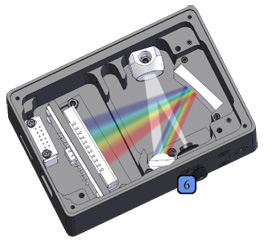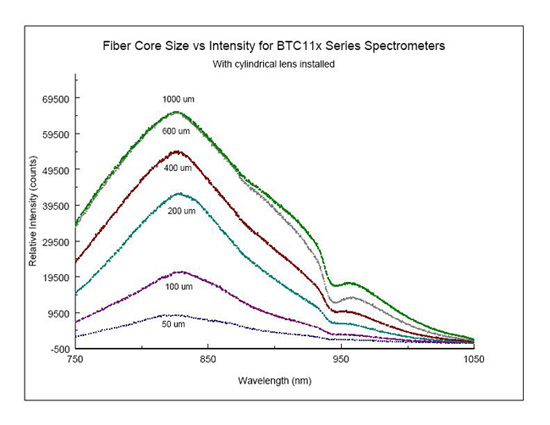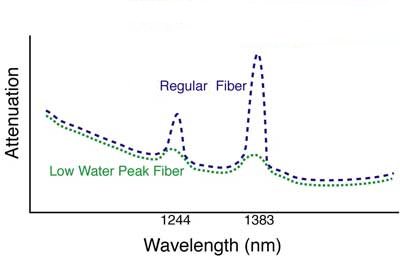Part 6: Choosing a Fiber Optic
Overview
 When configuring a spectrometer for a given experiment, one of the commonly overlooked considerations is in choosing the best fiber optic cable. Although there are many different factors to consider for this choice, this section will focus on the following two key factors: core diameter and absorption.
When configuring a spectrometer for a given experiment, one of the commonly overlooked considerations is in choosing the best fiber optic cable. Although there are many different factors to consider for this choice, this section will focus on the following two key factors: core diameter and absorption.
First, we will briefly review what a fiber optic cable is and how it is used to direct light into a spectrometer. Then, we will discuss the two characteristics stated above and why they are important for determining the throughput of the fiber optic.
Technical Details:
A fiber optic can be thought of as a “light pipe”. If you consider how the pipes in a home direct water from one location to another by guiding it through twists and turns to the desired location, you can recognize that fiber optics guide light waves in a similar fashion. Instead of directing light to a bathroom or kitchen, though, we are interested in guiding the light into a spectrometer or other optical detection system. This is achieved by a process known as total internal reflection.
In order to understand how total internal reflection is achieved, we must first look at the optical property known as refraction. Refraction arises because the speed of light varies based on the material it is traveling through. As a result, when light transitions from one medium to another, the angle at which the light is traveling is retarded relative to the interface.
The refracting power of a material is defined as
![]()
Equation 6-1
where n is the index of refraction, v is the speed of light in the medium of interest, and c is the speed of light in a vacuum. For example, the index of refraction of air is 1.000293, which shows that the speed of light in air is almost exactly the same as it is in a vacuum, whereas the index of refraction of water is 1.333, showing that light travels 25% slower in water than in a vacuum.
The relationship between the index of refraction and the angle at which light travels is defined by Snell’s law
![]()
Equation 6-2
From this equation, we can see that the refracted angle (θ2) is dependent on the ratio of the indices of the two materials (n1/n2) as well as the incident angle (θ1). As a result, by controlling the ratio of the indices, one can engineer the refracted angle such that all of the light is reflected back from the interface. This is known as total internal reflection and is the method that allows for light to be contained and guided inside of a fiber optic.

Figure 6-1
Figure 6-1 illustrates how a fiber optic is designed to facilitate total internal reflection by using two different types of glass, a lower index cladding, and a higher index core in order to trap the light within the core of the fiber and guide it through the fiber optic. This ability to collect light from one place and direct it to another is the reason fiber optic cables are the ideal solution for coupling light into a spectrometer.
Core Diameter:
Since all of the light in a fiber optic is collected in the core, the diameter of the core directly correlates to the amount of light that can be transmitted. Based on this principle, it would seem intuitive that a larger core diameter will improve the sensitivity and signal-to-noise ratio of a spectrometer. While this is true to a certain extent, there are other limiting factors that need to be considered when selecting the right fiber optic.
The first thing to consider is the pixel height of the detector. As shown in previous sections, the optical bench of a spectrometer is designed to form an image of the slit onto the detector plane. If the detector pixels are only 200µm in height and you select a 400µm core fiber, 50% of the light incident on the detector is wasted. In this case, there appears to be no advantage gained from having a larger core, but there is a way to get around this issue by adding a cylindrical lens into the optical bench in front of the detector.

Figure 6-2 Signal Intensity for Various Core Diameters with a Cylindrical Lens Installed
The cylindrical lens focuses the image of the slit in the axis orthogonal to the array without distorting the image along the axis parallel to the array in the detector plane. This allows for the light from the entire core to be directed onto the pixel, greatly increasing the sensitivity of the overall setup. Figure 6-2 shows that this approach works quite well up to a 600µm core fiber.
Absorption:
Another important factor to consider is the absorption properties of the fiber optic. If the light is absorbed by the fiber, it will never be detected by the spectrometer.
During the traditional manufacturing process for fiber-optics, OH– ions are inadvertently doped into the glass by the plasma torches used to soften the bulb so that it can be drawn into fibers. The presence of these ions creates very strong absorption bands (known as water peaks) in the NIR, which can greatly interfere with the ability to make broad band measurements through this region. In order to avoid this when using fiber optics for NIR spectroscopy, fiber optics need to be manufactured using special low OH– plasma torches.

Figure 6-3
Inversely, there are also severe absorption properties in the UV spectrum. This property arises from a photo-chemical effect known as solarization, which worsens over time with extended UV exposure, especially below 290nm.
For these reasons, it is extremely important to pay close attention when selecting a fiber for a specific application. When operating in the NIR spectra, make sure to choose low OH– fibers optics (also commonly called NIR fiber optics). When working in the visible and near UV spectral region, standard fiber optics commonly referred to as UV fiber optics are acceptable.
Browse our extensive line of spectrometers.
Submit your questions using the “Request Quote or Info” button above, or call us at (302) 368-7824.







